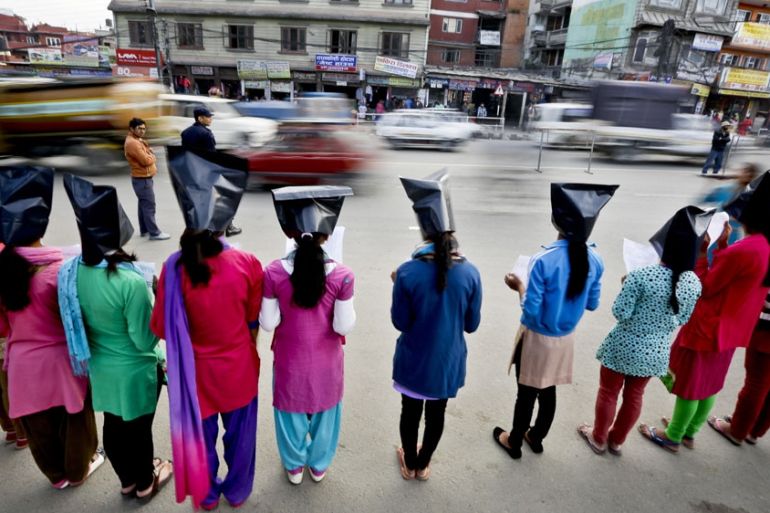Still getting away with rape in Nepal
When the rest of the world is talking about #MeToo, in the South Asian nation the conversation feels like a non-starter.

Kathmandu, Nepal – On March 8, 2015, six-year-old Puja Saha finally died.
For more than two weeks, her small body had been attached to life-saving machines at the intensive care unit of Kathmandu’s Kanti Children’s Hospital.
Keep reading
list of 4 itemsNigeria’s women drivers rally together to navigate male-dominated industry
Members of London’s Garrick Club vote to let women join for first time
Why has Australia declared a ‘national crisis’ over violence against women?
A police officer stood guard outside the room. Puja’s father, Badri Narayan Saha sat outside, desperate with agony, crying intermittently.
Those who talked to him ended up crying too.
The details of the crime were shocking. The young girl had not only been raped but the rapist had inserted pieces of wood inside her vagina.
She was found in a rubbish pile the day after she disappeared. The violence with which she was attacked, abused, violated and eventually shocked the nation for a while.
An average of three rapes are reported in Nepal every day.
Nobody knows how many are not reported. Two times? Five times? Ten times that number?
It takes unbelievable amounts of courage for most women and girls to put themselves out there and report rape.
When Badri Narayan realised that his daughter was missing, late evening one day back in late February 2015, he had a bad feeling.
There had been a series of incidents of rape in Bara. Puja was found the next day.
Writhing in pain
The local police took her to Narayani Zonal hospital.
When Badri Narayan rushed there, he found his daughter unattended, writhing in pain, blood all over the hospital bed.
Since the police were involved, the doctors did not want to intervene.
Badri Narayan asked the state to help him. When he called the Chief District Officer (CDO), the panicked father was told that he should have done a better job of protecting his daughter.
|
|
“Was I to carry her on my shoulders? Would she not play around our shop?” Badri Narayan said.
It did not occur to him that it was the CDO’s job to maintain law and order. It was the CDO who had failed, not him.
As a street vendor of cheap cosmetics, Badri Narayan had little authority at the best of times.
When the broken man was told that it would cost him over a thousand dollars to get his daughter to Kathmandu, he fainted.
He pleaded with the police before Puja finally was brought to Kathmandu in a helicopter.
For 17 days, the city watched Puja as Badri Narayan kept vigil for his daughter, afraid to pull the ventilator from the girl pronounced “brain dead”.
Anger of women
On international women’s day, three years ago, with Puja’s death, a small part of humanity died.
The anger of women spilled onto the streets. When Bara district court finally gave the rapist, Kanhai Gupta, a 35-year sentence, the anger quietened.
The maximum penalty for rape under the Nepalese Penal Code is 20 years.
Rape has been normalised by now. It is the “background wallpaper for news”, as Rebecca Solnit says in her essay The Longer War.
It’s only when the violations are outrageous, when small children are raped, when women are assaulted by gangs, when the police refuse to register cases, when survivors are victimised by state and non-state actors, that the stories get space in the newspapers.
On the eighth page of Nepal’s largest daily, a day before the third anniversary of Puja’s death, sits a story about a 12-year-old girl who was raped and killed.
The man simply took the liberty to help himself to a young girl who was out gathering fodder.
Then he took her shawl, wrapped it around her neck and squeezed the life out of her.
And again, last month, an eight-year-old was raped and killed in Khotang.
Urgency for action
There are stories of judges letting go of perpetrators, of police refusing to file the cases, and stories of state representatives forcing women to get married to their rapists, so that they can be raped for the rest of their lives.
It’s 2018. The rest of the world is talking about #MeToo and in Nepal, like much of South Asia, the conversation feels like a non-starter.
Stories of violence against women and girls are omnipresent and there is an urgency for action.
Once again, women in Kathmandu have to and will protest against rape on International Women’s Day.
Their minds will be crowded by the Puja, Sita and Gita.
Fear, anger and rage is a good way to divert women.
It will exhaust us and it will silence us.
It will give us very little time to think about all the other things that we might want.